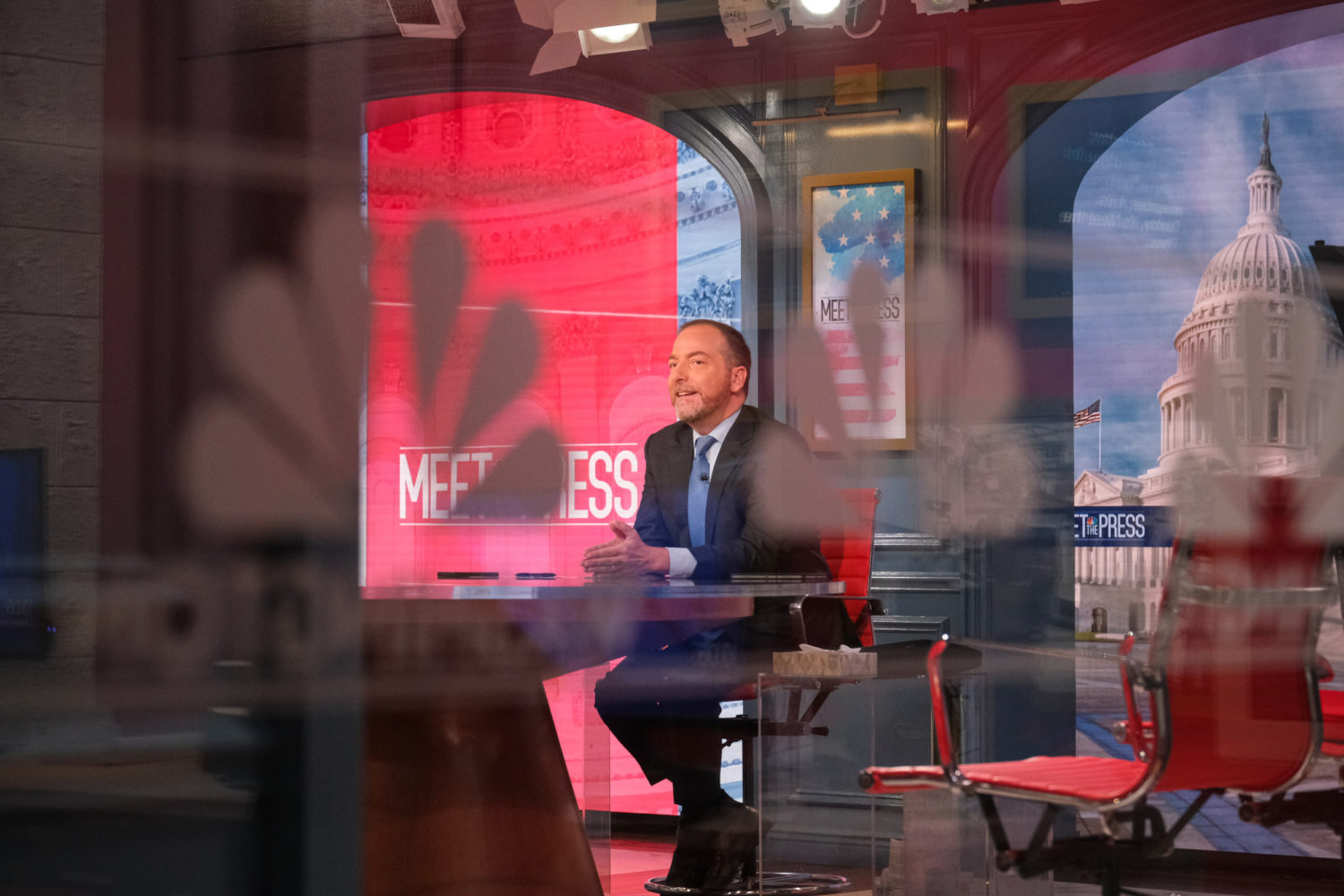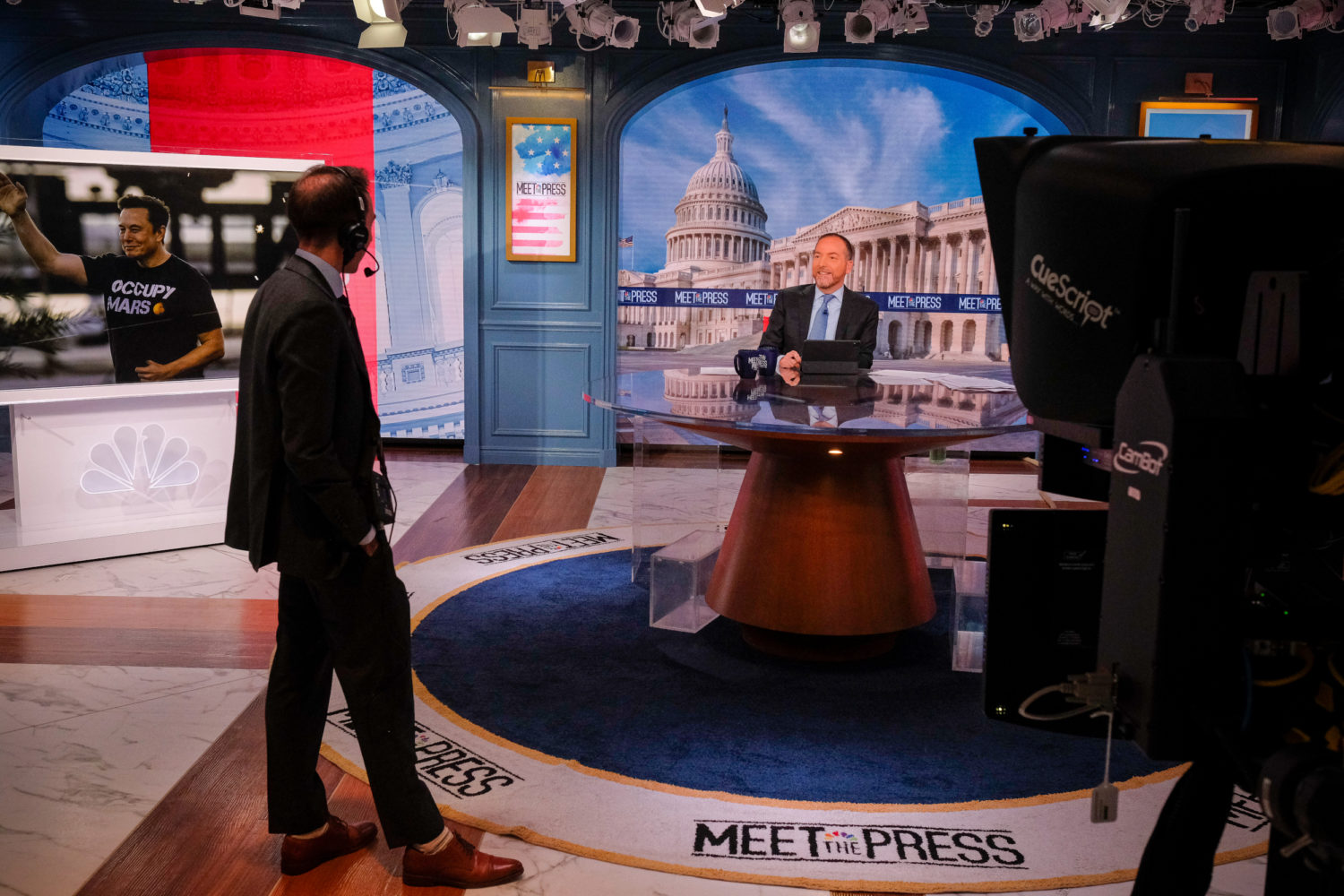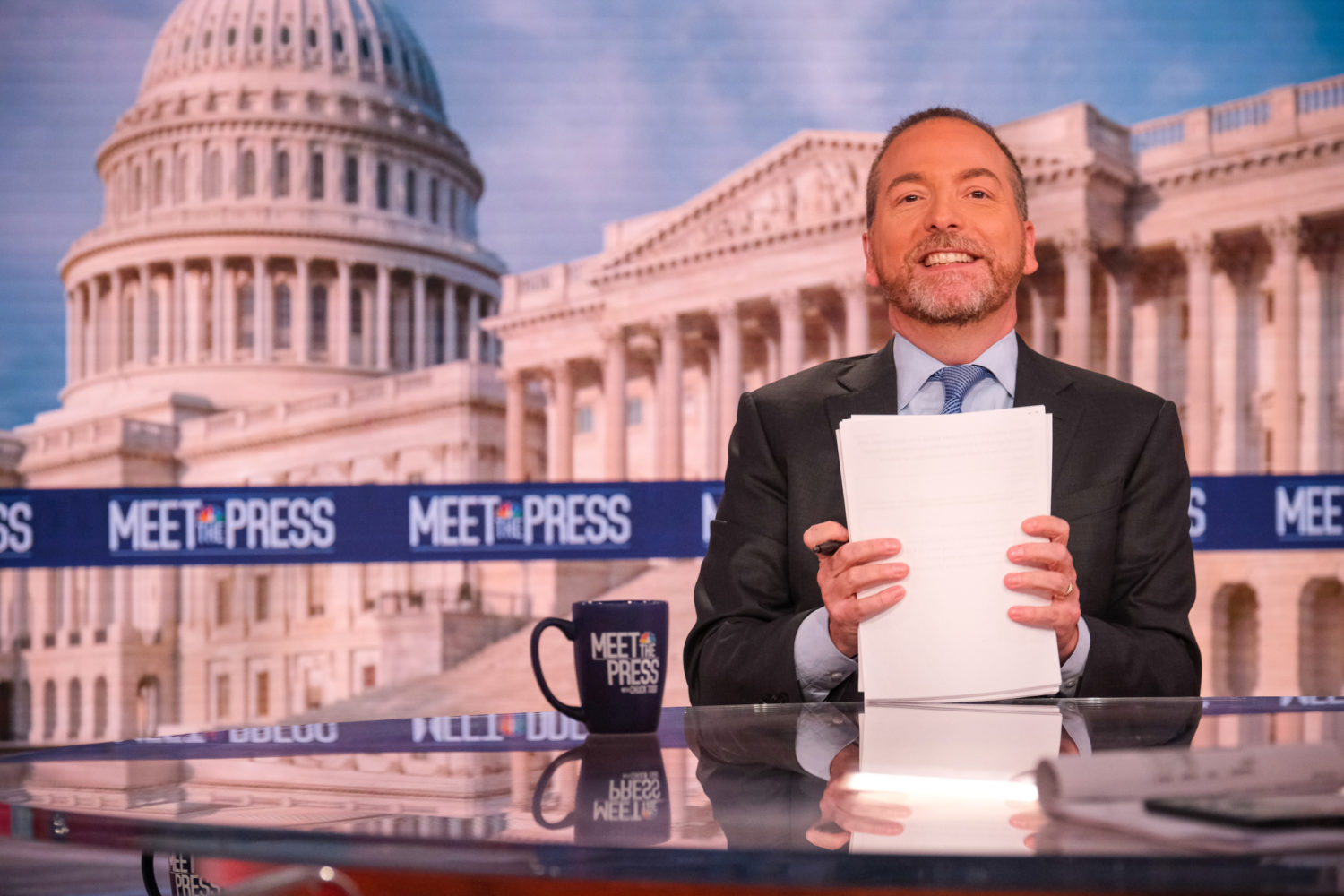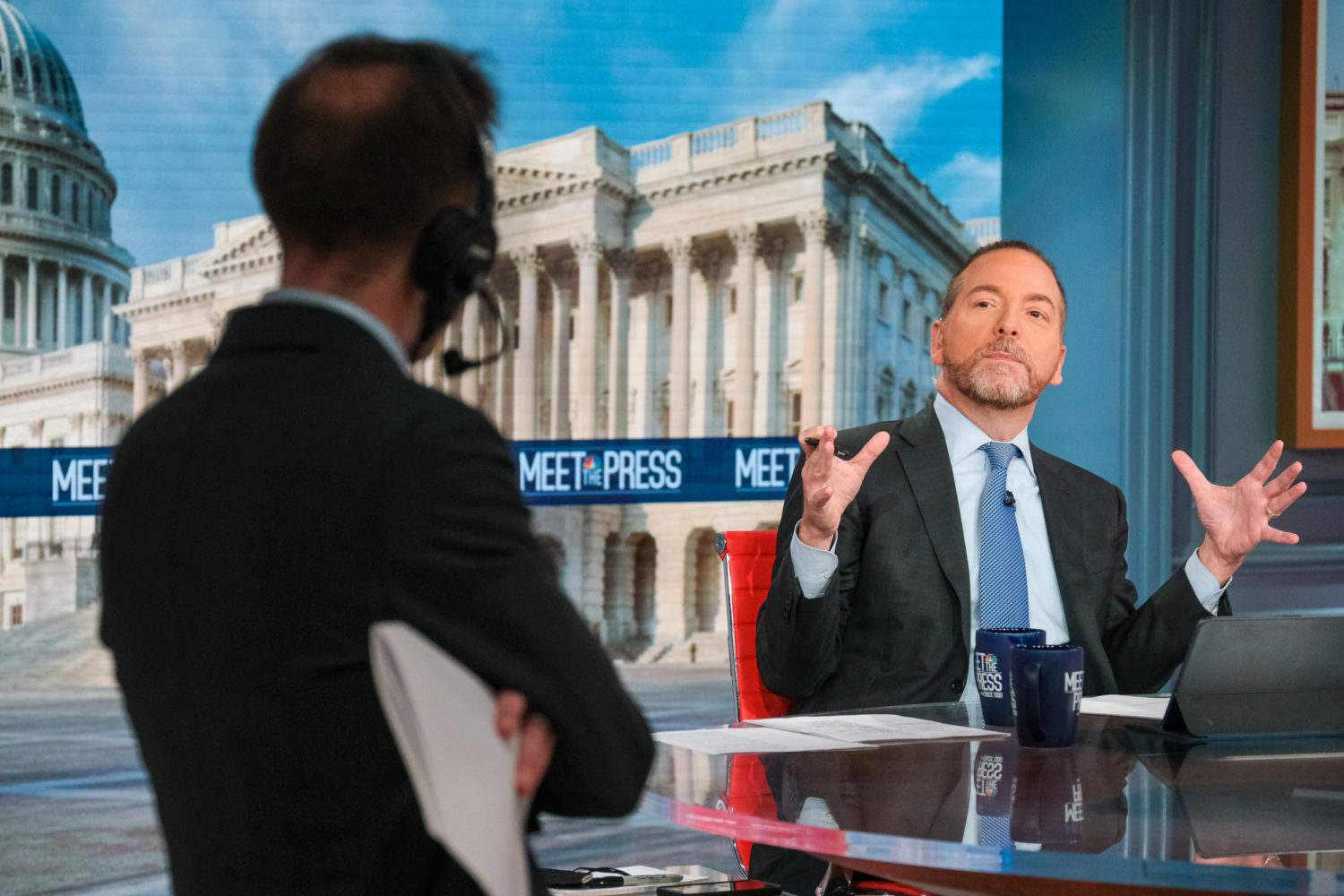Poynter senior media writer Tom Jones spent a recent Sunday watching the taping of the iconic Sunday morning news show and talking to its moderator, Chuck Todd. They talked about the show’s mission, the criticism Todd catches each Sunday on Twitter and just how much longer he wants to moderate the longest-running show on TV.
WASHINGTON, D.C. — It’s a little after 8 a.m. on a recent Sunday morning and “Meet the Press” moderator Chuck Todd is taping a two-minute segment called “Data Download.” At the NBC News studio in the shadow of the U.S. Capitol, Todd is standing in front of a touchscreen full of numbers that change each time he brushes his fingers over it. With his naturally accessible style of talking, Todd is breaking down young voter numbers and what they could mean to this week’s midterm elections.
This is the second time Todd is recording this. The first go-around got a tad wordy and the touchscreen was a little wonky. You could tell halfway through that it was never going to make it to air.
The second try is much smoother. The screen works perfectly, and “MTP” executive producer David Gelles, who was hovering nearby, seems pleased. Full taping of this particular episode of “Meet the Press” starts in less than an hour. With panelists set to arrive soon and revisions to the script still needing to be finalized, it’s time to move on to what’s next.
“You know what?” Todd says to no one in particular, and yet everyone in the studio. “Let’s do that again. I still think it can be better.”
Cameras are reset, the screen is reloaded, floor manager Brian Gessner yells out, “We’re going again, quiet in the studio please,” and Todd does the whole segment over. This one better work, or it might have to be done live. The third time sounds as good as the second, but Todd says, “Yeah, that’s better. I like that one.”

Chuck Todd tapes “Meet the Press” Oct. 30 in Washington, D.C. At left is Brian Gessner, the show’s floor manager. (William B. Plowman/Courtesy of NBC)
Only now can Todd and the “MTP” staff of about 40 can move on to what’s next — putting together another episode of the longest-running show on TV. On Sunday, “Meet the Press” celebrated its 75th anniversary. While the show celebrated this diamond anniversary by looking back at some of its most notable guests and storied moments, it also recognized the importance of the moment — that we are now within hours of what could be the most critical midterm elections of our lives.
Todd and “Meet the Press” tackle it like they tackle every show.
“I look at it in this respect,” Todd said. “The show has to both live in the moment and live in the archives.”
Todd and his staff constantly ask, “What are we going to look back on 25 years from now?”
These days, that question is easy.
“In 25 years,” Todd said, “we are going to look back and ask, ‘What was the biggest issue in 2020?’ We’re going to say democracy. We’re not going to say inflation.”
As I observed a recent Sunday of a “Meet the Press” taping, democracy — or, more specifically, the threat to democracy — was the theme. Typically, planning for the Sunday show starts in earnest on Wednesdays. Topics are discussed, panelists and panel discussions are considered and, most importantly, guests (usually politicians or newsmakers) are lined up.
The theme for this particular week was supposed to be “Closing Arguments” — as in candidates making their final case in the week before election day. But that all changed on that Friday when Paul Pelosi, husband of House Speaker Nancy Pelosi, was attacked in his home.
“This became what I would call a pivot show,” Gelles said as the show was about to begin taping.
The show pivoted to a lead story of “Violent Assault,” which looked not only at the Pelosi attack but the violence stirred up by political rhetoric. While this left the “MTP” crew scrambling right up until the moment taping began, it wasn’t really that unusual.
Todd and Gelles arrive at the studio around 6 a.m. By 6:30, most of the “MTP” staff is at their desks or in editing rooms (or racing between there and the studio) putting together graphics, videos and all the other bells and whistles that go into making a Sunday morning news show look snazzy. The show tapes at 9 a.m, but airs on most NBC affiliates at 10 a.m.
This particular Sunday morning took extra elbow grease because of the late pivot. While Todd was redoing (and redoing) his “Data Download” on the first floor, the opening montage, with the John Williams theme music playing under ominous warnings and images of violent attacks, was being spliced together on another floor, using video meticulously collected throughout the week. The whole morning was chaotic. But it was controlled chaos, with no raised voices, no tantrums and plenty of “pleases” and “thank yous” among the staff.
But the show was still in scramble mode from the time Todd arrived until the show’s taping ended at 10 a.m.
“I’ve been doing this for eight years,” Todd said, “There’s not anything that I haven’t already experienced.”
“Yeah,” Gelles said. “Actually, this turned out to be a typical show.”

Moderator Chuck Todd appears during a taping of “Meet the Press” in Washington, D.C., on Oct. 30 (William B. Plowman/Courtesy of NBC)
What is a typical show?
“Meet the Press” debuted on Nov. 6, 1947. The original format was just what the show’s title suggested. World leaders, politicians and newsmakers being questioned by the press. Over the years, the show has evolved to what it is today, which is Todd usually interviewing one or two newsmakers, followed by panel discussions that include journalists, strategists and political influencers.
For Todd, “Meet the Press’ ” mission statement is simple: inform, educate, explain.
“(Viewers) are looking for somebody to weed out the nonsense,” Todd said. “I feel like one of my missions each week is to focus on what mattered and let people know what didn’t matter. … What are we teaching the viewer today? How are we educating them today? I think that’s where the Sunday shows in general should stand out. We’re your weekly Ted Talk.”
Todd later said, “If there’s one question that I’m always dealing with it’s, ‘Why?’ I’m trying to explain the why or I’m trying to get someone else to give me the answer to why. It’s not what. We all got the whats. The whats are everywhere. The why is the hardest answer to get out of people.”
And when he doesn’t get a guest to explain the why, Todd becomes the target of the social media mob. Instead of chasing Todd with pitchforks and torches, they go after him on Twitter.
For the record, yes, Todd is well aware that he trends on Twitter on Sunday mornings. He doesn’t read the comments, but he is aware of what is said about him. He gets it from all sides.
Conservative viewers think he’s just another member of the Lame Stream Media carrying water for Democrats. They believe he targets conservatives and unfairly grills and criticizes.
Meanwhile, the left’s complaint is that he gives platforms to conservatives to spread misinformation and doesn’t follow up with enough real-time fact-checks. Both sides, ironically, complain about both-sideism. And his fiercest critics complain that he is no Tim Russert, an all-time fan favorite who moderated the show from 1991 until his untimely death in 2008.
Todd makes no apologies: he’s not there to be an activist journalist.
“There’s a role for activist journalism, but not on ‘Meet the Press,’” Todd said. “And not in mainstream media.”
He continued, “Most of the critiques of the Sunday shows are not coming from people who are serious journalists. They’re coming from people who are political activists. And I say this with no disrespect. There’s nothing wrong with being an activist.”
That’s just not who Todd is. And not, he says again, who he should be. While Twitter rages, Todd shrugs.
“If you can’t take criticism then don’t be a journalist; go be an activist,” he said. “If you’re worried about trending or you want your ‘likes,’ you’re not being a journalist.
Who are the guests?
There’s an old saying around the halls of “Meet the Press”: The people they want to book don’t want to come on the show. And those who want to come on are those the show doesn’t want to book.
Why do politicians come on? Mostly because they want to get their message across — first, to their colleagues in Washington. Among Sunday shows, “Meet the Press” has had the most total viewers in the Washington, D.C., market for 91 consecutive months, a span of more than seven years.
But the appearances are also a way for policymakers to get their message out to the rest of the country. The Sunday shows, while not as popular as they used to be when there were fewer TV choices, still draw big audiences. “Meet the Press,” ABC’s “This Week” and CBS’s “Face the Nation” generally each attract viewership in the 2.2 million to 2.7 million range, sometimes more depending on the news cycle. That doesn’t count subsequent viewing on streaming services and YouTube.
On a recent “Meet the Press” — the show about violent attacks — the guests were Democratic Sen. Amy Klobuchar of Minnesota and New Hampshire Republican Gov. Chris Sununu. Neither was in the studio, but did their interviews remotely.
Todd’s interview with Sununu is an example of what can frustrate viewers. Sununu, it should be noted, did express sympathy for Pelosi’s husband and condemned the attack. But when Todd asked Sununu about democracy being under threat and Sununu’s thoughts on election deniers, Sununu turned the discussion back to Democrats and then about how there are more important matters to voters, such as the economy.
In an 11-minute interview, Todd needed to dedicate time to as many topics as he could, but he did ask Sununu at least four times about election deniers. Still, Todd often gets blamed when politicians don’t give the answers some viewers are looking for.
“I understand why extreme activists on the left and the right get (vocal) because we’re the reality check,” Todd said. “‘Meet the Press’ is the reality check of what actually happened and what actually matters. The activists are all pushing what they want to matter and what they want the takeaways to be. So we’re the truth tellers. We’re the answer key. I get it. You’re bummed when your answer is not the right answer.”
The other complaint of “Meet the Press” (and, by extension, Todd) is about interviewing people who are untruthful and untrustworthy.

“Meet the Press” moderator Chuck Todd talks with executive producer David Gelles, during a taping of “Meet the Press. on Oct. 30. (William B. Plowman/Courtesy of NBC)
Gelles, who leads the booking of the show, jumps in to say, “We are in the business of covering politics. It’s not our job to pick and choose the leaders. The American people get to do that. And so our job is to make sure that the American people understand who the people in power are, what they stand for and what they plan to do.”
Interestingly, the 75th anniversary show recalled times when “Meet the Press” interviewed people like Joseph McCarthy, Fidel Castro and Yasser Arafat. The show even had former KKK Grand Wizard David Duke.
Gelles said, “George Will said it best: Why do you interview dictators? Because they are there.”
But isn’t putting on an election denier or someone who supported the Jan. 6 insurrection irresponsible and even dangerous? Or how about the time when Trump advisor Kellyanne Conway said a White House press secretary used “alternative facts?”
“There are some extreme points of view out there that have serious numbers of followers,” Todd said. “Do you want to stick your head in the sand? Or do you want to understand what the heck they’re up to and what motivates them?”
On the 75th anniversary show, Betsy Fischer Martin, the former executive producer of “Meet the Press” talked about Russert, who used to say if he could go back in time to interview anyone he wanted, his first choice would be Jesus. Russert’s second choice?
“Adolf Hitler,” Fischer Martin said. “And he would always say that these cameras here are the best disinfectant. You put the sunlight on it, and it really hits home.”
As far as today’s political climate, Todd sees too many people divided into their own camps, listening only to themselves. Or, as Todd puts it, “People are not listening in stereo. They are basically in mono politically. Too much so.”
He adds, “I find the idea of not interviewing people because of their beliefs not very small-d democratic. That’s certainly not the environment that I want to live in.”

Moderator Chuck Todd tapes “Meet the Press” Oct. 30. (William B. Plowman/Courtesy of NBC)
How much longer?
Todd has been moderating “Meet the Press” since 2014. He’s now 50 and married with two children. He said he remains enthusiastic about moderating and loves nothing more than covering politics — well, except for football, especially the University of Miami and the Green Bay Packers.
He calls into Tony Kornhesier’s podcast each week to give his pigskin predictions.
And speaking of football, he sees Tuesday’s midterms and every election night as his Super Bowl. Gelles said he has never seen anybody love the ins and outs of elections and election coverage like Todd.
Todd’s “Meet the Press” duties now extend to Monday through Friday, when he hosts “Meet the Press NOW.” It’s a grind, but Todd says the daily shows have absolutely helped make the signature Sunday show even better.
Todd hesitates when asked what his favorite thing about moderating “Meet the Press” is. There are so many things, but he settles on, “My favorite part is figuring out the first thing you say on Sunday morning; that I get to contribute to shaping the conversation in a better way.”
He enjoys moderating the iconic show but doesn’t know how long he will do it. Back in August, The Daily Beast’s Lachlan Cartwright hinted that Todd could be replaced by Kristen Welker, but those rumors, if even true in the first place, seemed to have died down.
Still, Todd straddles the lines of saying he is not done, but he doesn’t plan on doing the show forever. He said he can’t see himself doing the show as long as Russert, who moderated for 17 years. That would give Todd another nine years or so.
“There should be a sell-by date on all journalists in Washington,” Todd said. “I’m a believer that you shouldn’t have one person in a beat forever. But I’m not done growing this show. I’m certainly not going anywhere anytime soon. But I know how long Tim did it and I wouldn’t do it that long. So there ya go. There’s a number.”







